This blog is sort of like a podcast, only you have to read it. It’s basically a conversation between me and my friend/colleague, Charlie Reid, about yoga and resistance stretching. We email often, so this is a glimpse into one of our email threads, just formatted to read more like a blog. Oh, and the cat photos have been removed and replaced with content related images.
Jules: Hey Charlie, when we last spoke about stretching you said something I’ve been thinking about a lot lately. You said you don’t even know what the word “stretching” means anymore. Everyone seems to have a dogmatic view of exactly what it is and what it does (or does not do). The working title of the book I’m currently writing is actually called Yoga Biomechanics: Redefining Stretching. Since it will take me about 100,000 words to redefine stretching, I’d never ask you to do that here. But can you tell us a little about what you think “resistance stretching” means and does.
Charlie: I feel like if you spend enough time on a topic, it starts to look something like Keanu Reeves character “Neo” in the Matrix when he starts to see that his world was just made up of a series of ones and zeros. Stretching, when we can see the through to the ones and zeros, is really two sides of the same coin. You said it best when you defined stretching as “a tensile load.”
In this regard, stretching is just another way to apply force to the body in hopes of getting a favorable response. What really grinds my gears though is when we apply the wrong tool at the wrong time for a given movement objective. For example, I read an article a while back titled “Yoga for Runners.” In my opinion, yoga has about as much to do with running as a screen door on a submarine. Perhaps there is an argument for mindfulness side of things which I am not going to touch on, but the physical attributes of asana are not specific enough to running. So, if someone came to me to be a better runner, yoga would be very low on my list of priorities to improve performance for the stated objective. And for the yogis out there, if flexibility is one of your goals, a deadlift done properly will improve your forward bend faster than forward bending alone. Strength carries over to flexibility more than flexibility carries over to strength.
I think we all need to step back and look at what our outcome measure is, define it, and then apply the right tool for the task. We have bought into this thought-virus that stretching is antagonistic to strength training. When, in reality, we know that you can improve range of motion from strength training [1]. Even something as simple as a light cardiovascular warm-up improves range of motion!
Which brings me to resistance stretching – which really is a way of improving usable range of motion by actively lengthening a muscle eccentrically. I see this type of work as a form of neuromuscular re-education whereby one applies a novel eccentric stimulus through a range of motion without pain or perceived threat. It is a wonderful way to experience full control of a joint throughout its range which is often not possible in other forms of movement or stretching. In this regard, it’s a nice way to teach movement and control of a joint through a range of motion utilizing all contraction types (concentric, isometrics, and eccentric).
And my question to you, Jules, is why doesn’t yoga teach active muscular control into and out of poses? Why not add isometric contractions at end range to either acquire more range or, at the very least, have active control of those end ranges?
Jules: Wow, there is a lot of good stuff in there Charlie. I’ll comment on of the some of the highlights before moving the conversation forward.
First off, I love that you brought up specificity again. You and I have hashed this out plenty of times and I’m still not done exploring the topic. In fact, just last week I skyped briefly with Todd Hargrove about his blog on the SAID principle. We were discussing a recent article on yoga for speed skaters [2].
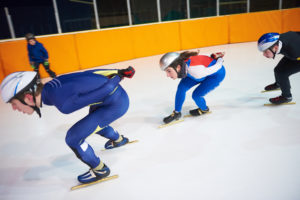 (image by Dreamstime)
(image by Dreamstime)
The study set out to determine if 1) yoga could improve efficiency of movement by increasing range of motion in 3 specific postural tests, 2) increasing total training hours by adding yoga would not interfere with other training activities, and 3) the risk of injury could be reduced. The subjects yoga’d for 8 weeks while continuing their regular training protocol. At the end of the intervention, mobility improved, performance in non-yoga activities was maintained and no injuries occurred as a result of all training activities. This doesn’t actually say much, does it? Yet, in the discussion section the article reads, “head coaches felt that the athletes were more capable of dissociating their torso from their hips and thus increased the efficiency of their skating stride.” How do we know the head coaches didn’t already want yoga to improve their performance? If the head coaches hated yoga and thought it was stupid, would they have “felt” the same way? Are there other ways to improve mobility in less time? Could they achieve the same outcomes while also training in a more sport specific task that would have greater carry-over?
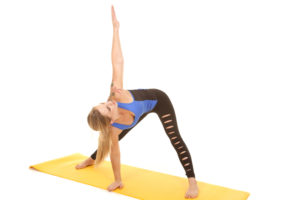 (image by Dreamstime)
(image by Dreamstime)
So, let’s talk more about the deadlift. I know you want to. 🙂 I love how you said deadlifting will improve your forward bend because strength carries over to flexibility more than flexibility carries over to strength. I want to point out that strength isn’t a one way street. You should have strength while lifting the bar and strength while lowering the bar. I was once interviewed for a fitness article and asked if I could give “one easy tip” on how to incorporate eccentric exercise into a workout routine. I said “free weights.” Unless you’re dropping the weight between each rep of your bicep curl, you’re already incorporating eccentric training at some level. It’s another thought-virus we’ve bought into – that good old strength training isn’t enough and we need expensive equipment, complicated systems, and a collection of “top ten” blogs to teach us how to load the body effectively.
That said, I think resistance stretching is a super effective way of introducing load where you can specifically train end ranges. If you define stretch as a tensile load, you can then get specific about how you want to load for your specific outcomes. As you said, if “improving usable range of motion” and “experiencing full control of a joint throughout its range” are your outcomes, then resistance stretching would serve you far better than, say, free weights or passive stretching.
You then followed up with a big question, asking me why yoga doesn’t teach at a very minimum isometrics at end range. Well, Charlie, some of us actually do teach that!
Yoga is complicated just like any other movement “system.” People have expectations about what they want their workout routine to do for them. But with yoga, I think people assign the extra quality of needing to feel good. I think it’s easy for people to expect a long run or a heavy lifting session to be challenging. But yoga promises relaxation and warm fuzzies – people come to yoga to heal.
This is not wrong. Where yoga as a healing practice falls short is when yoga is your only movement modality of choice. And since this is often the case, you now find yoga teachers departing from the classical repertoire of postures and adding variable loading. This naturally comes with criticism. I once saw a comment on an online class of mine that said she doesn’t feel good during/after my classes. I’ll be the first to say that I don’t follow the rules of warm fuzzy and I veer far from classical sequencing to achieve specific outcomes. I suggest that if you get plenty of loading in your life and you’re coming to yoga to feel awesome and “recover” from your workouts, then yeah, you should probably try one of my restorative classes or go with another teacher all together. But if yoga is your main jam, then be willing to redefine not just stretching and what it does, but yoga as well.
So that brings me to the point of our conversation thread. At the upcoming Resistance Stretching Symposium we are combining forces (pun intended) and teaching a breakout session on blending the genres of yoga and resistance stretching. We verbally created a rough outline last time we were together, but you took the notes. Can you share the details here along with some of your thoughts?
Charlie: Great points, Jules. I think a lot of the controversy over yoga and specificity comes down to identifying qualities and training them systematically. As you mentioned with the Brunelle 2015 study done on speed skaters, yoga may be beneficial for hip dissociation and mobility. When we look at the component parts, however, there may be more sport-specific ways to acquire that mobility and hip dissociation without yoga.
That being said, I understand that there are other factors to consider when assigning a certain training method. Yoga also provides a lot of focus on mindfulness and breath work, which might be beneficial. So, in summary, I think that when it comes to real-world applicability, having options is a good thing as applying the most sport-specific technique might not always be feasible. However, if there is a certain training method that accomplishes something more specific to the activity being trained (or accomplishes more than just one quality), then we should seek to implement that as a primary option.
At the upcoming Resistance Stretching Symposium, as we discussed, our breakout session will include the exploration of isometric and eccentric control into and out of yoga poses. More specifically, using yoga poses as a diagnostic and then applying tools from the specific style of resistance stretching called Dynamic Contraction Technique (DCT)* to allow the person to access areas that may have what I call “sensorimotor blind spots”.
For example, in a downward facing dog (adho mukha svanasana), there is often a sensation of “tightness” in an area like the hamstrings. However, it may not be the hamstring’s fault from a mechanical restriction perspective and, instead, could be a motor control problem wherein the person can’t find their hip flexors to help pull them into more flexion at the hip. Another possibility is that the hamstrings simply need to learn how to lengthen eccentrically without a perception of threat or guarding. And if flexibility is the goal, we know that eccentric contractions can contribute to flexibility while also increasing strength [3]. A win-win.
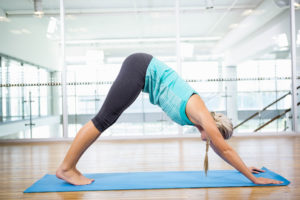 (image by Dreamstime)
(image by Dreamstime)
Another hallmark of our breakout is our emphasis on language. More specifically, using a neuro-ceptive, or brain-based description for what is happening with the application of resistance stretching when working with a client. This may be different than other more mechanistic, or biomechanical, descriptions used to describe various stretching techniques. In the words of Moshe Feldenkrais, “I am not seeking to develop flexible bodies, but flexible minds.”
This is not to say that the hardware of the body are not important, however, I would argue that much of the instantaneous changes we are achieving during a resistance stretching session is likely mediated by our nervous system allowing greater range of motion and/or control, not necessarily from lengthening tissue or “breaking adhesions.” Remodeling of tissue most likely occurs over a longer time frame as long as the stimulus is consistent and adequate enough to elicit adaptation. And the amount of force needed to actually deform fascia would be highly unlikely in the manner with which we perform the technique [4].
Jules: I’m going to run with the diagnostic portion for a moment since I think that will be of most interest for yoga teachers. As you said, flexibility is not always a function of tissue restrictions. In fact, it’s most often not. I like say in my courses, “you have enough tissue to be a fully functioning mover.” This isn’t always intuitive based on the language we share as yoga teachers (lengthen, open, release, etc.). And since yoga people love to “stretch,” I think using resistance stretching as a diagnostic tool will be a big hit.
I love that you mentioned in the downdog example above that the usable short range of the hip flexors may be the culprit for lack of hip flexion. This goes against yet another thought-virus that hip flexors always need releasing and are stuck at short range.
Similarly, in the case of malasana (full squat), it could be that the tibialis anterior is failing to dorsiflex the ankle rather than the Achilles tendon being “tight.” Stretching the gastroc may be a futile effort whereas some full range loading of the tib. anterior may result in greater yield for the gastroc simply by re-educating the muscles of the foot ankle complex.
Charlie: Yeah, I figured we could use 2-3 poses as a way to help people do a more comprehensive problem-solving formula for why someone may be limited or unable to get into certain positions. We would use the pose as a test/retest, perform real-time diagnostics based on where the client feels restricted, and also throw in some passive range of motion assessments to identify if the limitation is potentially more of a structural/morphological issue. This would be congruent with our talk about differentiating neurally-mediated restriction vs. someone simply having a hip capsule that is restricted or a bony block that will not respond to an active technique. For example:
Downward Dog
- Test position/ask client where they feel restricted.
- Analyze the joint angles of hip flexion, ankle dorsiflexion, knee flexion, spinal extension, shoulder flexion.
- Perform breakouts using real-time diagnostics (DCT, active ROM)
- Retest pose after each muscle group is assessed
- Go to passive ROM if not getting desired result (identify closing angle pinching, end feel, etc.)
We will probably only have time for 2 or 3 poses as this can get pretty involved. But it should give people enough to go on for assessing other postures.
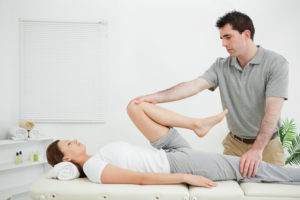 (image by Shutterstock)
(image by Shutterstock)
Jules: Yes, I think capsular restrictions and bony blocks are often assumed to be the same thing in yoga because the prevailing thought reduces ROM limitations to bony compression (anatomical end range) or soft tissue tension (stretch it out to increase range). But capsular restrictions are not exactly either of these and can be resolved with deliberate loading. Let’s for sure cover that!
Finally, you had inquired separately from this conversation thread about why yoga doesn’t teach using the glutes in bridge and the lats and serratus in chaturanga. Again, I think plenty of us actually do teach that (don’t know where you’re getting your yoga from!). Time permitting, what do you think about ending our session with some DCT for those poses (or as you call them, “dead-end poses”) and then incorporating this neuromuscular re-education into the poses?
Charlie: Let’s do it.

Jules: Cheers.

*DCT is a restistance stretching technique created by Nic Bartolotta (the creator of the Resistance Stretching Symposium) that Charlie and I utilize personally and with our clients.
Register for the 2nd annual Resistance Stretching Symposium here.
__________________________________________________
[1] Morton, S. K., Whitehead, J. R., Brinkert, R. H., & Caine, D. J. (2011). Resistance Training vs Static Stretching: Effects on Flexibility and Strength. Journal of Strength and Conditioning Research, 25(12), 3391–3398.
[2] Brunelle, J.-F., Blais-Coutu, S., Gouadec, K., Bédard, É., & Fait, P. (2015). Influences of a yoga intervention on the postural skills of the Italian short track speed skating team. Open Access Journal of Sports Medicine, 6, 23–35.
[3] O’Sullivan, K., McAuliffe, S., & Deburca, N. (2012). The effects of eccentric training on lower limb flexibility: a systematic review. British Journal of Sports Medicine, 46(12), 838–845.
[4] Chaudhry, H., Schleip, R., Ji, Z., Bukiet, B., Maney, M., & Findley, T. (2008). Three-dimensional mathematical model for deformation of human fasciae in manual therapy. The Journal of the American Osteopathic Association, 108(8), 379–390.

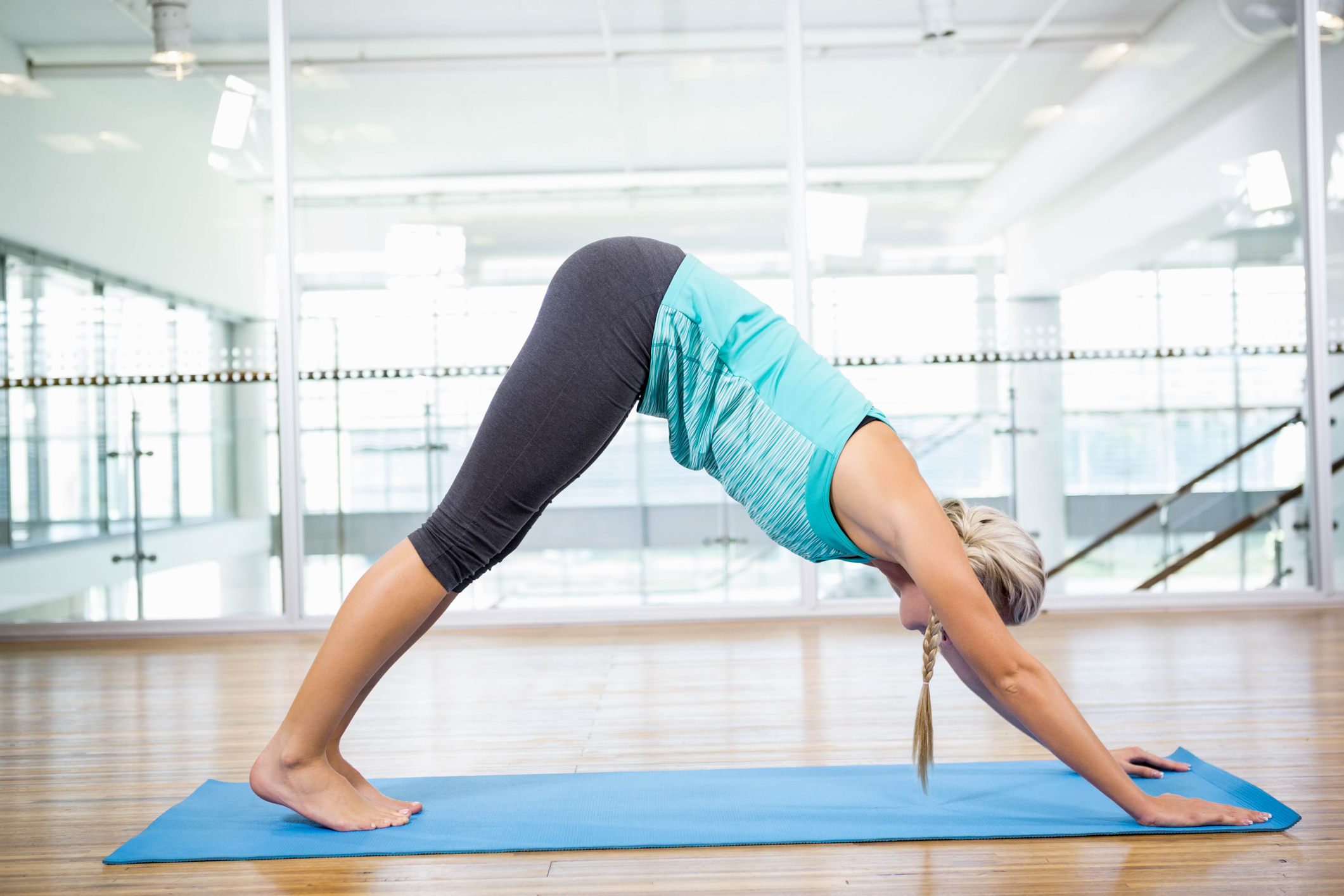
Thanks Jules and Charlie! I loved finding this in my inbox after being at a presentation on active stretching versus active shortening at the cellular level. So great to see to see how this work can be applied.
This kind of dialogue is what I hope we find more and more of in the future of yoga. Rather than spending a lot of time learning asana by heart (and their often less than useful sanskrit names), it would be incredibly empowering in Teacher Trainings to spend some time teaching students a solid grasp of biomechanics fundamentals and some protocols to test and develop strength/flexibility and then unleash them into an in depth personal practice. Thanks Jules for sharing!